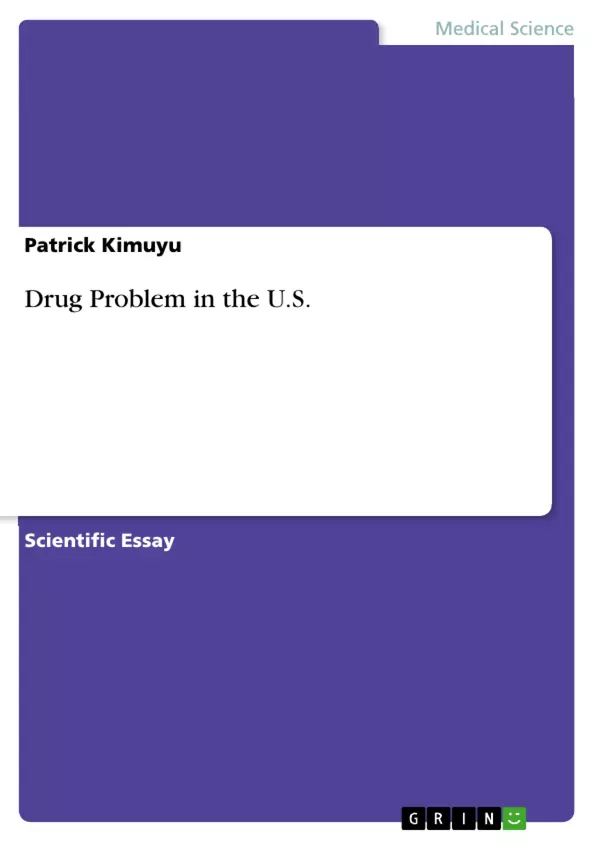Over decades, the United States has experienced devastating consequences from illicit drug use. Foremost, the drug menace has led to an immense burden to the public healthcare system through expenditure on the treatment of substance use disorders. Today, abuse of prescription drugs, primarily opioids is causing the highest number of deaths in the U.S. history. On the other hand, illicit drug use has been causing economic losses over the years, leading to increases in government expenditure on drugs every year. For instance, the country was estimated to have lost $193 billion in 2007 only due to illicit drug use, especially in lost productivity, health and crime. These consequences are the key reason why the US has not relented on the war against drugs. Over the past decades, the federal government has been carrying out reforms in the justice system with attempts to break the cycle crime and drug use (Kerlikowske, 2012). The main focus has been reducing drug trafficking, drug production and drug related transnational threats. Despite the concerted efforts by different Administrations since the declaration of ‘War on Drugs’ by President Nixon in 1971, it is apparent that the U.S. has not yet been able to end drug menace. In the past four decades, deaths from drug abuse have been increasing, annually, and this phenomenon is evidenced by statistics for the past decade. According to the U.S. Food and Drug Agency [FDA] (2013), prescription drugs abuse deaths increased from 66.7% in 2000 to 77.5% by 2010. In reference to these statistics, it is explicit that the United States’ Government’s response has not been adequate to combat drugs.
Inhaltsverzeichnis (Table of Contents)
- Introduction
- The U.S. Drug Problem
- Federal Government's Response
- Drug Courts
- Increased Support to Drug Law Enforcement Agencies
- Securing National Borders
- Reducing Prescription Drug Abuse
Zielsetzung und Themenschwerpunkte (Objectives and Key Themes)
This document analyzes the drug problem in the United States, examining its devastating consequences and evaluating the effectiveness of federal government responses over the past three decades. The main focus is on understanding the impact of drug abuse on the U.S. economy, human resources, and public health.
- The widespread impact of illicit drug use on the U.S. population, including public health, economy, and human resources.
- The federal government's strategies to combat drug abuse, including drug courts, increased law enforcement support, border security, and prescription drug abuse reduction.
- The effectiveness of these strategies in reducing drug-related deaths, crime, and economic losses.
- The challenges and complexities of drug control, highlighting the ongoing battle against drug trafficking and abuse.
- The significance of national and international partnerships in addressing the global drug problem.
Zusammenfassung der Kapitel (Chapter Summaries)
The introduction highlights the devastating consequences of illicit drug use in the United States, including the burden on healthcare systems, economic losses, and rising drug abuse deaths. It emphasizes the ongoing fight against drug trafficking and production.
The chapter titled "The U.S. Drug Problem" presents a comprehensive analysis of the drug issue from an epidemiological perspective. It details the alarming statistics of drug abuse, particularly among teenagers, and the significant impact on the primary care system. This chapter also examines the insufficient access to treatment for substance abuse disorders and the increasing government expenditure on drug control.
The chapter "Federal Government's Response" outlines the key strategies implemented by the federal government to combat the drug menace. This includes the development of the National Drug Control Strategy, which focuses on reducing drug flow, disrupting trafficking networks, addressing transnational threats, curbing economic losses, and strengthening international partnerships.
The chapter further explores specific responses such as the establishment of drug courts, increased support for drug law enforcement agencies, securing national borders, and implementing strategies to reduce prescription drug abuse.
Schlüsselwörter (Keywords)
This document focuses on the drug problem in the United States, examining the impact of drug abuse on public health, the economy, and human resources. It analyzes the effectiveness of federal government responses, including drug courts, increased law enforcement support, border security, and prescription drug abuse reduction. Key terms include illicit drug use, drug trafficking, drug abuse, substance abuse disorders, national drug control strategy, drug courts, law enforcement, border security, prescription drug abuse, and international partnerships.
- Quote paper
- Patrick Kimuyu (Author), 2018, Drug Problem in the U.S., Munich, GRIN Verlag, https://www.grin.com/document/388762



